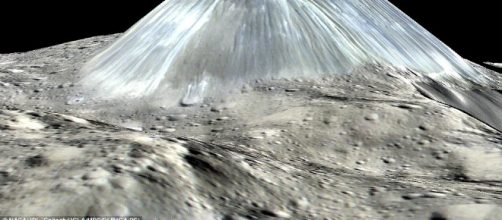Dawn, the NASA probe currently orbiting the dwarf planet Ceres, has made a remarkable geologic discovery, the space agency reported. Ahuna Mons is an ice volcano and was recently active on a geological time scale. Scientists are comparing it, in appearance, to Tolkien’s “Lonely Mountain” from “The Lord of the Rings” trilogy.
Volcanoes usually spew out soot and molten rock, covering the landscape around them, like Vesuvius in Italy or Mount St. Helens in Washington State. Ice volcanos, such as on Saturn’s moon Enceladus, spews out ice, sometimes mixed with mud and salts.
However, Dawn is a dwarf planet, made up of salts, muddy rocks, and water ice. It should not be the venue of an ice volcano, yet there it is.
Moreover, the fact that Ahuna Mons is a sharp, well-defined mountain that resembles a volcano dome suggests that it is a relatively recent feature. Most of the surrounding landscape is well rounded, having been bombarded by meteor impacts. Most mountains tend to erode and slump under gravity as well.
The next step that scientists intend to take is to examine Ahuna Mons and the surrounding environs with a visible and infrared mapping spectrometer instrument onboard the Dawn. The instrument will use reflected light to identify the chemical composition of the ice volcano.
Whatever is revealed will give scientists and insight into what is inside Ceres and possibly an idea of how heat in generated that drove the ice volcano to start with.
Dawn is a unique space probe in that it has visited two deep space destinations since it was launched nine years ago. The probe used an ion engine to orbit the asteroid Vesta for just over a year in 2011 and 2012 before proceeding to Ceres, where it arrived in March 2015.
Even though Ceres resides in the asteroid belt, that area of irregularly shaped rocky bodies between the orbits of Mars and Jupiter thought to be left over from the formation of the solar system, it is considered a dwarf planet. Dwarf planets, which also includes Pluto, are spherical objects of a certain size that, in the judgment of some astronomers, do not qualify as full-fledged planets.

